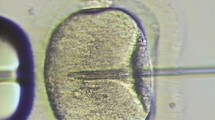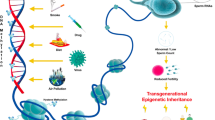Abstract
Infertility in humans and subfertility in domestic animals are two major reproductive problems. Among human couples, ~15 % are diagnosed as infertile, and males are considered responsible in about 50 % of the cases. To examine male fertility, various sperm tests including analyses of sperm morphology, sperm count and sperm mobility are usually performed. Teratozoospermia, a condition characterized by the presence of morphologically abnormal sperm, is considered as a symptom of infertility. B10.MOL-TEN1 (TEN1) mice (Mus musculus) show inherited teratozoospermia at high frequencies (~50 %). In this study, the polygenic control of teratozoospermia in the TEN1 strain was analysed. A quantitative trait loci analysis indicated three statistically significant loci, Sperm-head morphology 3 (Shm3; logarithm of the odds (LOD) score, 29.25), Shm4 (LOD score, 6.80), and Shm5 (LOD score, 3.58). These three QTL peaks were mapped to 24.3 centimorgans (cM) on chromosome 1, 32.0 cM on chromosome X, and 63.8 cM on chromosome 6, respectively. Another locus that is yet to be determined was also predicted. Shm3 was found to be the major locus responsible for teratozoospermia, and a sequential cascade of interactions of the other three loci was apparent. These results are expected to help understand the mechanisms underlying reproductive problems in humans or domestic animals.





Similar content being viewed by others
References
Aitken RJ (2006) Sperm function tests and fertility. Int J Androl 29(1):69–75
Browman KW, Sen S (2009) A guide to QTL mapping with R/qtl. Springer, New York
Browman KW, Wu H, Sen S, Churchill GA (2003) R/qtl: QTL mapping in experimental crosses. Bioinformatics 19(7):889–890
Flachs P, Mihola O, Simeček P, Gregorová S, Schimenti JC, Matsui Y, Baudat F, de Massy B, Piálek J, Forejt J, Trachtulec Z (2012) Interallelic and intergenic incompatibilities of the Prdm9 (Hst1) gene in mouse hybrid sterility. PLoS Genet 8(11):e1003044
Furuse T, Yamada I, Kushida T, Masuya H, Miura I, Kaneda H, Kobayashi K, Wada Y, Yuasa S, Wakana S (2012) Behavioral and neuromorphological characterization of a novel Tuba1 mutant mouse. Behav Brain Res 227(1):167–174
Gotoh H (2010) Inherited sperm head abnormalities in the B10.M mouse strain. Reprod Fertil Dev 22(7):1066–1073
Gotoh H, Aoyama H (2012) Spermatogenic defects in F2 mice between normal mouse strains C3H and C57BL/6 without mutation. Congenit Anom (Kyoto) 52(4):186–190
Gotoh H, Hirawatari K, Hanzawa N, Miura I, Wakana S (2012) QTL on mouse chromosomes 1 and 4 causing sperm-head morphological abnormalities and male subfertility. Mamm Genome 23(7–8):399–403
Guzick DS, Overstreet JW, Factor-Litvak P, Brazil CK, Nakajima ST, Coutifaris C, Carson SA, Cisneros P, Steinkampf MP, Hill JA, Xu D, Vogel DL (2001) Sperm morphology, motility and concentration in fertile and infertile men. N Engl J Med 345(19):1388–1393
Handel MA, Lessard C, Reinholdt L, Schimenti J, Eppig JJ (2006) Mutagenesis as an unbiased approach to identify novel contraceptive targets. Mol Cell Endocrinol 250(1–2):201–205
Hirawatari K, Hanzawa N, Kuwahara M, Aoyama H, Miura I, Wakana S, Gotoh H (2015) Polygenic expression of teratozoospermia and normal fertility in B10.MOL-TEN1 mouse strain. Congenit Anom (Kyoto) 55(2):92–98
Jamsai D, O’Bryan MK (2011) Mouse models in male fertility research. Asian J Androl 13(1):139–151
Lewis SE (2007) Is sperm evaluation useful in predicting human fertility? Reproduction 134(1):31–40
Lucy MC (2001) Reproductive loss in high-producing dairy cattle: where will it end? J Dairy Sci 84(6):1277–1293
Maas JA, Garnsworthy PC, Flint AP (2009) Modelling responses to nutritional, endocrine and genetic strategies to increase fertility in the UK dairy herd. Vet J 180(3):356–362
Massart A, Lissens W, Tournaye H, Stouffs K (2012) Genetic causes of spermatogenic failure. Asian J Androl 14(1):40–48
Matzuk MM, Lamb DJ (2008) The biology of infertility: research advances and clinical challenges. Nat Med 14(11):1197–1213
Oehninger S, Franken DR, Ombelet W (2014) Sperm functional tests. Fertil Steril 102(6):1528–1533
Oka A, Mita A, Sakurai-Yamatani N, Yamamoto H, Takagi N, Takano-Shimizu T, Toshimori K, Moriwaki K, Shiroishi T (2004) Hybrid breakdown caused by substitution of the X chromosome between two mouse subspecies. Genetics 166(2):913–924
Peripato AC, De Brito RA, Matioli SR, Pletscher LS, Vaughn TT, Cheverud JM (2004) Epistasis affecting litter size in mice. J Evol Biol 17(3):593–602
Royal MD, Smith RF, Friggens NC (2008) Fertility in dairy cows: bridging the gaps. Animal 2(8):1101–1103
Shiroishi T, Sagai T, Moriwaki K (1982) A new wild-derived H-2 haplotype enhancing K-IA recombination. Nature 300(5890):370–372
Snell GD, Jackson RB (1958) Histocompatibility genes of the mouse. II. Production and analysis of isogenic resistant lines. J Natl Cancer Inst 21(5):843–877
Storchová R, Gregorová S, Buckiová D, Kyselová V, Divina P, Forejt J (2004) Genetic analysis of X-linked hybrid sterility in the house mouse. Mamm Genome 15(7):515–524
Visser L, Repping S (2010) Unravelling the genetics of spermatogenic failure. Reproduction 139(2):230–253
Vyskocilová M, Prazanová G, Piálek J (2009) Polymorphism in hybrid male sterility in wild-derived Mus musculus musculus strains on proximal chromosome 17. Mamm Genome 20(2):83–91
Wyrobek AJ, Gordon LA, Burkhart JG, Francis MW, Kapp RW, Letz G, Malling HV, Topham JC, Whorton MD (1983) An evaluation of the mouse sperm morphology test and other sperm test in nonhuman mammals. Mutat Res 115(1):1–72
Acknowledgments
The authors acknowledge the assistance of Mr. Heiichi Uchiyama with the experiments. We thank Dr. Shiroishi for providing the B10.MOL-TEN1 mouse strain. This work was supported by the Ministry of Agriculture, Forestry, and Fisheries, Japan.
Author information
Authors and Affiliations
Corresponding author
Electronic supplementary material
Below is the link to the electronic supplementary material.
Rights and permissions
About this article
Cite this article
Hirawatari, K., Hanzawa, N., Miura, I. et al. A Cascade of epistatic interactions regulating teratozoospermia in mice. Mamm Genome 26, 248–256 (2015). https://doi.org/10.1007/s00335-015-9566-y
Received:
Accepted:
Published:
Issue Date:
DOI: https://doi.org/10.1007/s00335-015-9566-y




